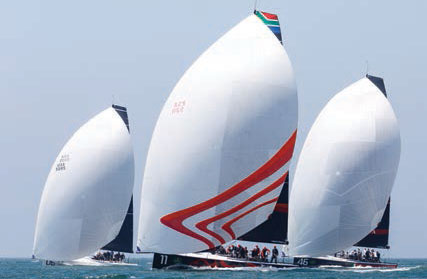

Where Contender’s original Superkote fabric came in a choice of one now there is a variant for every occasion...
With downwind sails, strength to weight ratio is critical, which is why many top sailing teams ask their sailmaker to specify Contender spinnaker cloth. The Superkote, Powerkote and Maxikote series together constitute a complete range of spinnaker fabrics that contain the right cloth for every type of spinnaker. When Superkote fabric was launched in 1986, there was one weight of cloth. Now there are 12, ranging from 31 grams per square metre up to 150g/sqm. The Contender range of spinnaker fabrics is used in everything from dinghies up to J-Class yachts and superyachts.
As the range of sail choice has expanded enormously in recent decades, the fabrics have had to develop to match that explosion of technology. Duncan Skinner, president of Contender US, explains: ‘Sailing has become an ever more technical sport where racing sailors are keen to exploit the smallest margins of advantage. Where you used to have the choice of a reacher or a runner for downwind, you now have a 1, an A2, an A2.5 and so on, because the design software and the designers are getting better and better all the time. And they expect the fabrics that they use to be on a par with their designs. Our portfolio of spinnaker cloth makes it possible for them to design pretty much any downwind sail they want.’
Roeland Wentholt, director of R&D at Contender Sailcloth Worldwide, says the current range is a significant evolution from the original “one size fits all” fabric launched in 1986. ‘America’s Cup teams were looking for ways to save weight in their downwind sails, and that’s where the drive to create lighter and lighter fabrics came from. Since then, boats have become so much faster and the high apparent wind angles mean we must develop cloth capable of withstanding those higher loads. Over the last 10 years we have developed our Powerkote range as a firmer finish on our Superkote constructions and our Maxikote range of polyester spinnaker fabrics for ultimate low stretch in both dry and wet conditions.
Below: taking things even further, a sail can be fully optimised for specific sailing conditions. Powerkote, Superkote, Maxikote and Superlite fabrics in various weights provide the perfect stability, stretch and weight characteristics for the different parts of the sail (image courtesy of North Sails)

For boats that sail in displacement mode most of the time, the nylon fabrics in the Superkote range tend to be the most popular choice among sailmakers. It’s a good all-round finish that caters to a wide range of applications. For more apparent wind sailing, Powerkote has the increased stability to better hold spinnaker shape in a pressured kite. Polyester Maxikote finds applications in larger A-sails where sail loads are high and shape retention is critical to performance. With this wide selection of fabrics, sailmakers can tailor their designs by selecting specific fabrics for optimal function within the same sail.
So much so that some asymmetric gennakers are even a combination of the two types of fabric, says Skinner. ‘You’ll see Powerkote in the front end and Superkote in the back end of an A-sail on a boat like a TP52,’ he says. ‘It’s also very popular in the bigger professionally crewed boats like the maxis and mini-maxis to have a Maxikote polyester tack box in a Superkote sail. With a loaded A-sail, the critical thing is to keep the luff projected forward of the boat and not have it sag to leeward. The higher bias stability and lower warp stretch in Powerkote or Maxikote gives you that.
‘Quite often the design philosophy of the sailmaker determines what is used,’ says Wentholt. ‘You have race teams who prefer to use spinnaker fabrics that are more stable in the bias than others. It also depends on what kind of conditions the boat is predominantly being raced in. Is it flat water or is it choppy? That can be a reason to choose Superkote or Powerkote.
‘If you typically sail in flat water most of the time, you might want to choose Powerkote because it’s more stable on the bias. If you have chop, if your rig is moving around and you don't have so much pressure, a sail which is slightly softer on the bias will set much easier. In this case the Superkote is more likely to be your best option.’
Contender’s fabrics are used by all the big-name sailmakers, but of course other providers of sailcloth are available. So it’s gratifying when a whole fleet of boats uses different sailmakers, but a 100 per cent is using Contender sailcloth. Wentholt recalls: ‘Watching the last ClubSwan 50 series before lockdown, to see the whole fleet coming downwind using sails made out of Superkote, that gives you a pretty good feeling that we’re doing something right.’
Click here for more information on Contender Sailcloth »
We invite you to read on and find out for yourself why Seahorse is the most highly-rated source in the world for anyone who is serious about their racing.
To read on simply SIGN up NOW
Take advantage of our very best subscription offer or order a single copy of this issue of Seahorse.
Online at:
www.seahorse.co.uk/shop and use the code TECH20
Or for iPad simply download the Seahorse App at the iTunes store

